Market Environment and Customer Needs Analysis for Red Bull
VerifiedAdded on 2023/01/17
|10
|2102
|65
Report
AI Summary
This report provides a comprehensive market analysis of Red Bull, examining its micro and macro environments. It delves into factors such as political, technological, and environmental influences, alongside the company's internal environment including employees, customers, and shareholders. The analysis includes segmentation and targeting strategies, focusing on demographic factors like age, gender, income, and occupation, and behavioral aspects of the target market. Furthermore, the report assesses Red Bull's key competitors like Coca-Cola, PepsiCo, and Monster Energy, as well as indirect competitors like Lucozade. Recommendations are offered to enhance Red Bull's market position, including expanding product ranges and refining communication strategies. The study concludes by emphasizing the importance of environmental analysis, competitor analysis, and customer understanding for the company's success.
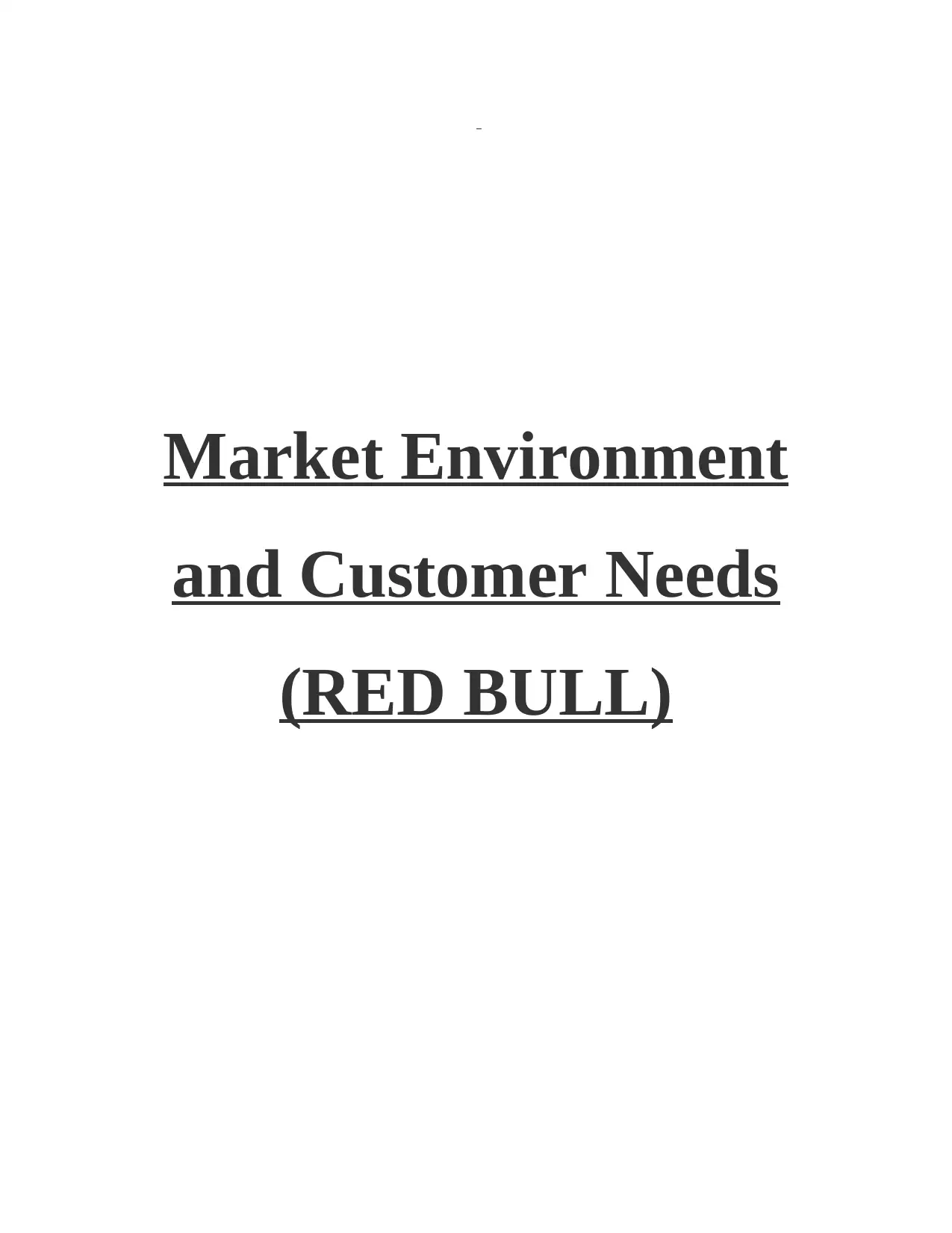
Market Environment
and Customer Needs
(RED BULL)
and Customer Needs
(RED BULL)
Paraphrase This Document
Need a fresh take? Get an instant paraphrase of this document with our AI Paraphraser
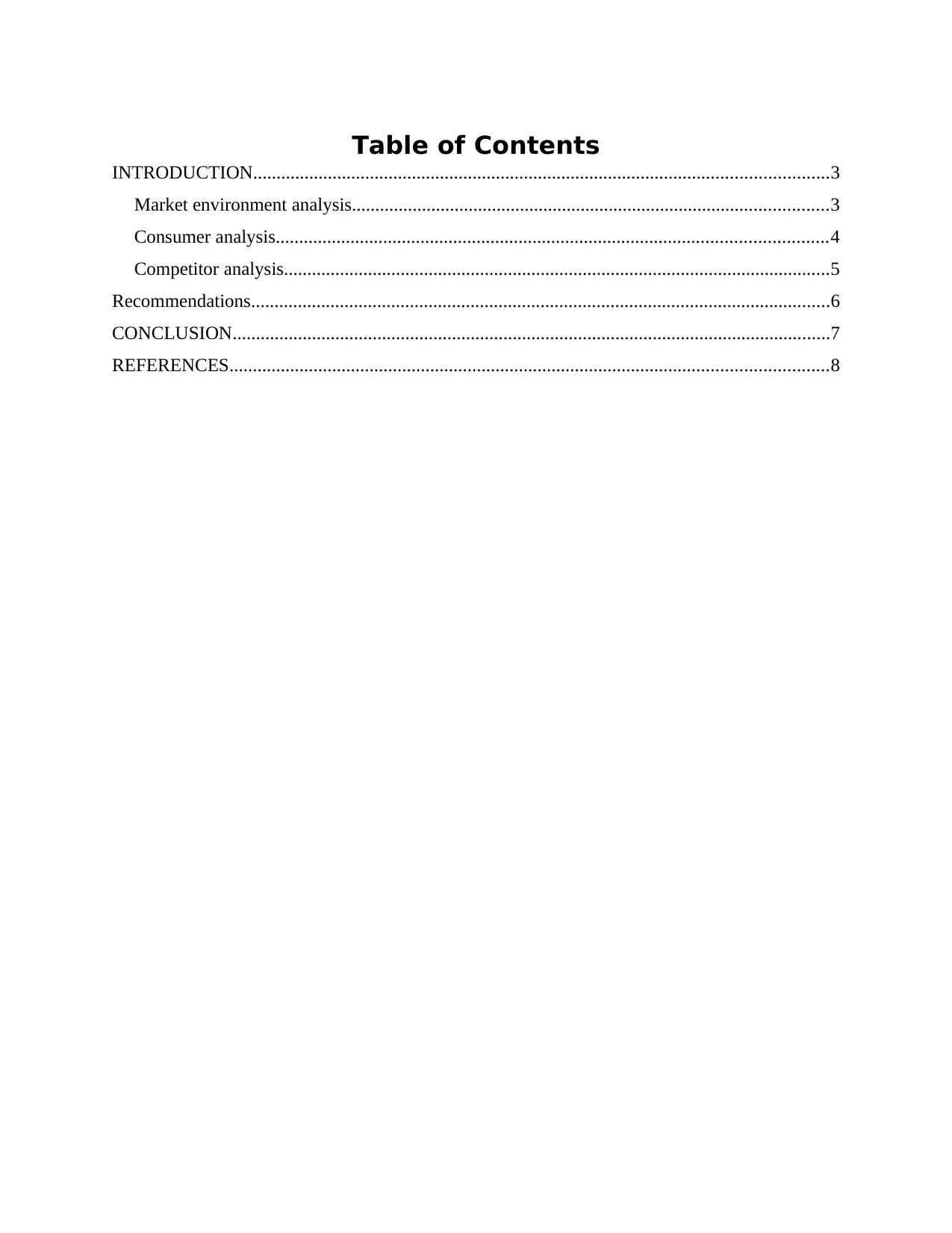
Table of Contents
INTRODUCTION...........................................................................................................................3
Market environment analysis......................................................................................................3
Consumer analysis......................................................................................................................4
Competitor analysis.....................................................................................................................5
Recommendations............................................................................................................................6
CONCLUSION................................................................................................................................7
REFERENCES................................................................................................................................8
INTRODUCTION...........................................................................................................................3
Market environment analysis......................................................................................................3
Consumer analysis......................................................................................................................4
Competitor analysis.....................................................................................................................5
Recommendations............................................................................................................................6
CONCLUSION................................................................................................................................7
REFERENCES................................................................................................................................8
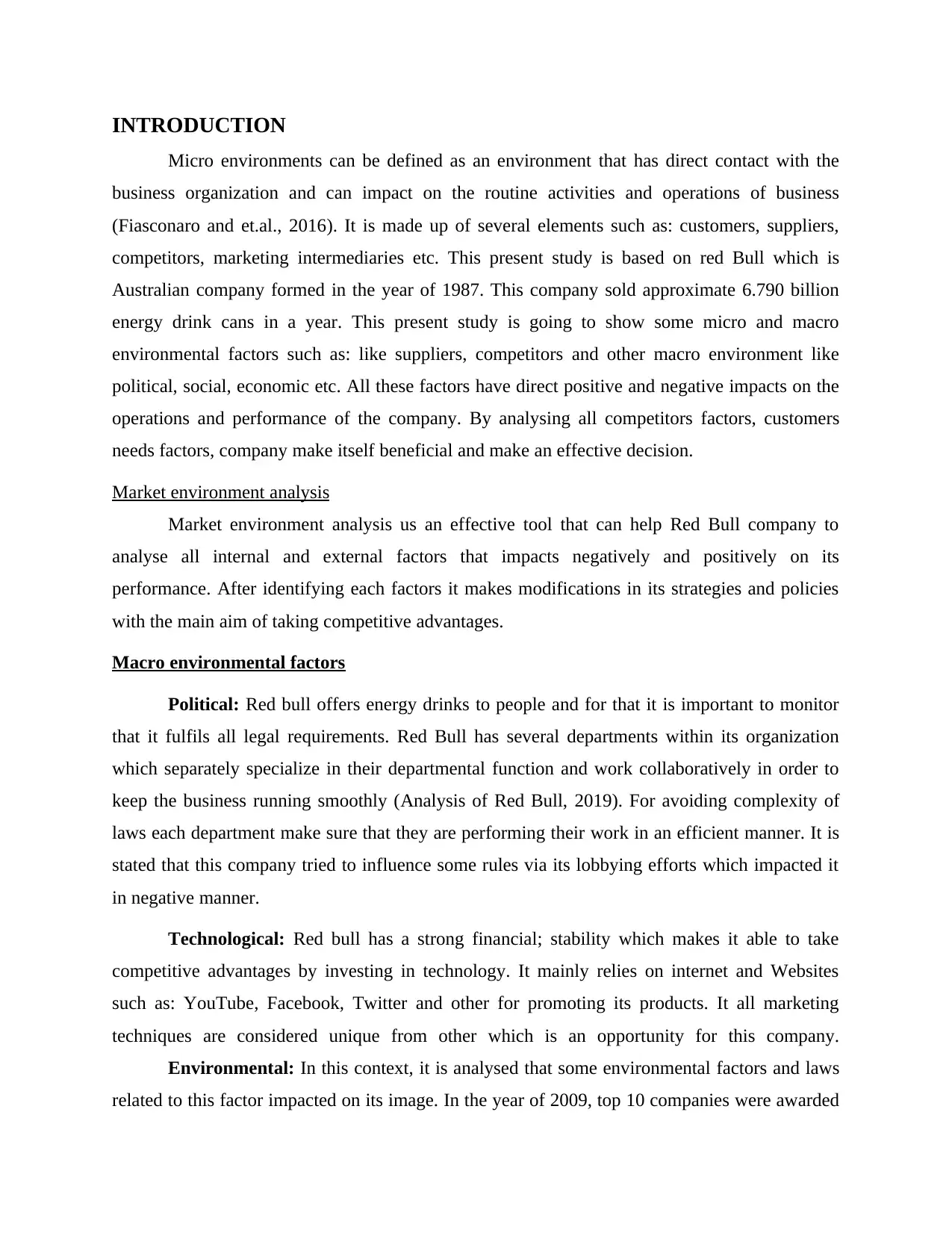
INTRODUCTION
Micro environments can be defined as an environment that has direct contact with the
business organization and can impact on the routine activities and operations of business
(Fiasconaro and et.al., 2016). It is made up of several elements such as: customers, suppliers,
competitors, marketing intermediaries etc. This present study is based on red Bull which is
Australian company formed in the year of 1987. This company sold approximate 6.790 billion
energy drink cans in a year. This present study is going to show some micro and macro
environmental factors such as: like suppliers, competitors and other macro environment like
political, social, economic etc. All these factors have direct positive and negative impacts on the
operations and performance of the company. By analysing all competitors factors, customers
needs factors, company make itself beneficial and make an effective decision.
Market environment analysis
Market environment analysis us an effective tool that can help Red Bull company to
analyse all internal and external factors that impacts negatively and positively on its
performance. After identifying each factors it makes modifications in its strategies and policies
with the main aim of taking competitive advantages.
Macro environmental factors
Political: Red bull offers energy drinks to people and for that it is important to monitor
that it fulfils all legal requirements. Red Bull has several departments within its organization
which separately specialize in their departmental function and work collaboratively in order to
keep the business running smoothly (Analysis of Red Bull, 2019). For avoiding complexity of
laws each department make sure that they are performing their work in an efficient manner. It is
stated that this company tried to influence some rules via its lobbying efforts which impacted it
in negative manner.
Technological: Red bull has a strong financial; stability which makes it able to take
competitive advantages by investing in technology. It mainly relies on internet and Websites
such as: YouTube, Facebook, Twitter and other for promoting its products. It all marketing
techniques are considered unique from other which is an opportunity for this company.
Environmental: In this context, it is analysed that some environmental factors and laws
related to this factor impacted on its image. In the year of 2009, top 10 companies were awarded
Micro environments can be defined as an environment that has direct contact with the
business organization and can impact on the routine activities and operations of business
(Fiasconaro and et.al., 2016). It is made up of several elements such as: customers, suppliers,
competitors, marketing intermediaries etc. This present study is based on red Bull which is
Australian company formed in the year of 1987. This company sold approximate 6.790 billion
energy drink cans in a year. This present study is going to show some micro and macro
environmental factors such as: like suppliers, competitors and other macro environment like
political, social, economic etc. All these factors have direct positive and negative impacts on the
operations and performance of the company. By analysing all competitors factors, customers
needs factors, company make itself beneficial and make an effective decision.
Market environment analysis
Market environment analysis us an effective tool that can help Red Bull company to
analyse all internal and external factors that impacts negatively and positively on its
performance. After identifying each factors it makes modifications in its strategies and policies
with the main aim of taking competitive advantages.
Macro environmental factors
Political: Red bull offers energy drinks to people and for that it is important to monitor
that it fulfils all legal requirements. Red Bull has several departments within its organization
which separately specialize in their departmental function and work collaboratively in order to
keep the business running smoothly (Analysis of Red Bull, 2019). For avoiding complexity of
laws each department make sure that they are performing their work in an efficient manner. It is
stated that this company tried to influence some rules via its lobbying efforts which impacted it
in negative manner.
Technological: Red bull has a strong financial; stability which makes it able to take
competitive advantages by investing in technology. It mainly relies on internet and Websites
such as: YouTube, Facebook, Twitter and other for promoting its products. It all marketing
techniques are considered unique from other which is an opportunity for this company.
Environmental: In this context, it is analysed that some environmental factors and laws
related to this factor impacted on its image. In the year of 2009, top 10 companies were awarded
⊘ This is a preview!⊘
Do you want full access?
Subscribe today to unlock all pages.

Trusted by 1+ million students worldwide
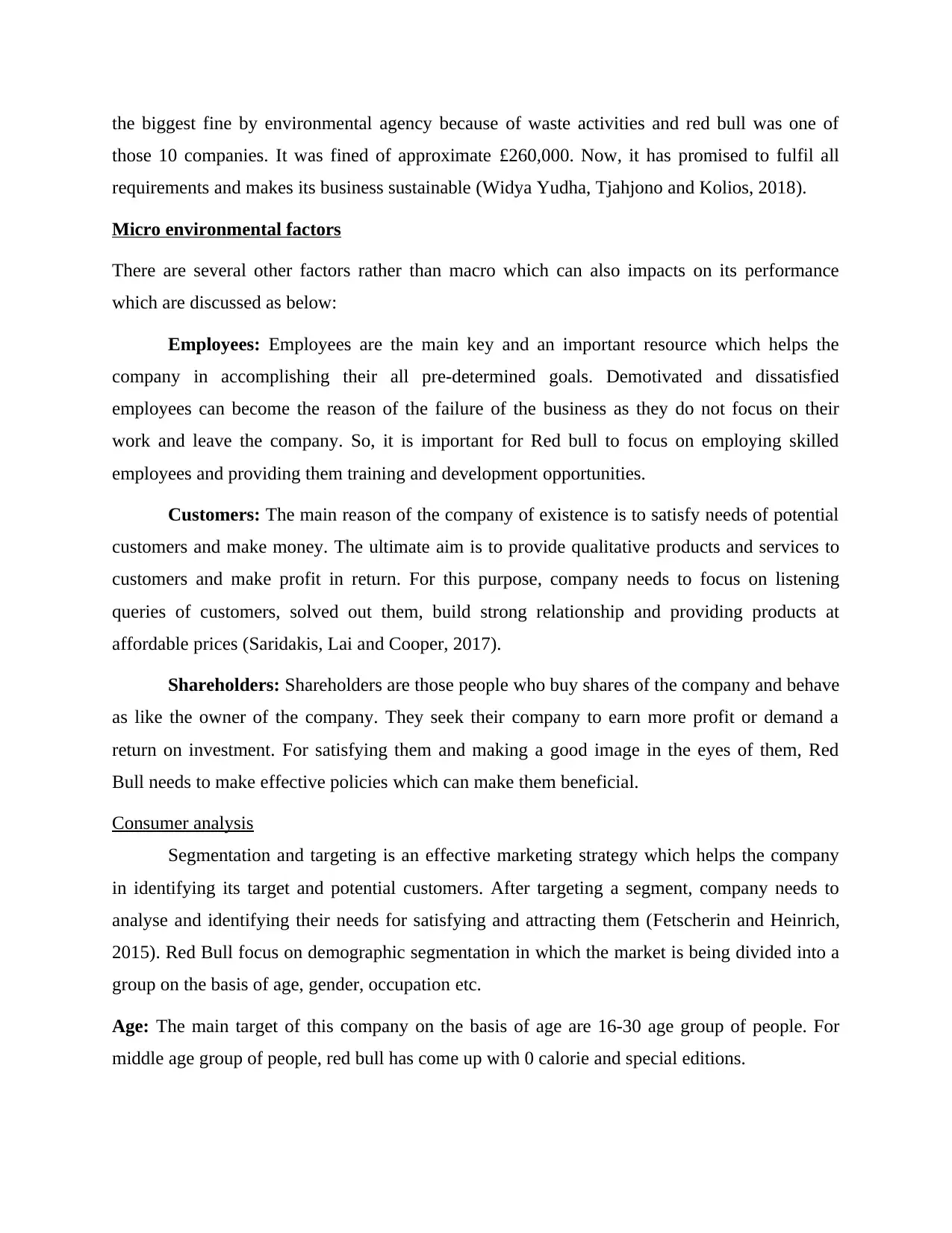
the biggest fine by environmental agency because of waste activities and red bull was one of
those 10 companies. It was fined of approximate £260,000. Now, it has promised to fulfil all
requirements and makes its business sustainable (Widya Yudha, Tjahjono and Kolios, 2018).
Micro environmental factors
There are several other factors rather than macro which can also impacts on its performance
which are discussed as below:
Employees: Employees are the main key and an important resource which helps the
company in accomplishing their all pre-determined goals. Demotivated and dissatisfied
employees can become the reason of the failure of the business as they do not focus on their
work and leave the company. So, it is important for Red bull to focus on employing skilled
employees and providing them training and development opportunities.
Customers: The main reason of the company of existence is to satisfy needs of potential
customers and make money. The ultimate aim is to provide qualitative products and services to
customers and make profit in return. For this purpose, company needs to focus on listening
queries of customers, solved out them, build strong relationship and providing products at
affordable prices (Saridakis, Lai and Cooper, 2017).
Shareholders: Shareholders are those people who buy shares of the company and behave
as like the owner of the company. They seek their company to earn more profit or demand a
return on investment. For satisfying them and making a good image in the eyes of them, Red
Bull needs to make effective policies which can make them beneficial.
Consumer analysis
Segmentation and targeting is an effective marketing strategy which helps the company
in identifying its target and potential customers. After targeting a segment, company needs to
analyse and identifying their needs for satisfying and attracting them (Fetscherin and Heinrich,
2015). Red Bull focus on demographic segmentation in which the market is being divided into a
group on the basis of age, gender, occupation etc.
Age: The main target of this company on the basis of age are 16-30 age group of people. For
middle age group of people, red bull has come up with 0 calorie and special editions.
those 10 companies. It was fined of approximate £260,000. Now, it has promised to fulfil all
requirements and makes its business sustainable (Widya Yudha, Tjahjono and Kolios, 2018).
Micro environmental factors
There are several other factors rather than macro which can also impacts on its performance
which are discussed as below:
Employees: Employees are the main key and an important resource which helps the
company in accomplishing their all pre-determined goals. Demotivated and dissatisfied
employees can become the reason of the failure of the business as they do not focus on their
work and leave the company. So, it is important for Red bull to focus on employing skilled
employees and providing them training and development opportunities.
Customers: The main reason of the company of existence is to satisfy needs of potential
customers and make money. The ultimate aim is to provide qualitative products and services to
customers and make profit in return. For this purpose, company needs to focus on listening
queries of customers, solved out them, build strong relationship and providing products at
affordable prices (Saridakis, Lai and Cooper, 2017).
Shareholders: Shareholders are those people who buy shares of the company and behave
as like the owner of the company. They seek their company to earn more profit or demand a
return on investment. For satisfying them and making a good image in the eyes of them, Red
Bull needs to make effective policies which can make them beneficial.
Consumer analysis
Segmentation and targeting is an effective marketing strategy which helps the company
in identifying its target and potential customers. After targeting a segment, company needs to
analyse and identifying their needs for satisfying and attracting them (Fetscherin and Heinrich,
2015). Red Bull focus on demographic segmentation in which the market is being divided into a
group on the basis of age, gender, occupation etc.
Age: The main target of this company on the basis of age are 16-30 age group of people. For
middle age group of people, red bull has come up with 0 calorie and special editions.
Paraphrase This Document
Need a fresh take? Get an instant paraphrase of this document with our AI Paraphraser
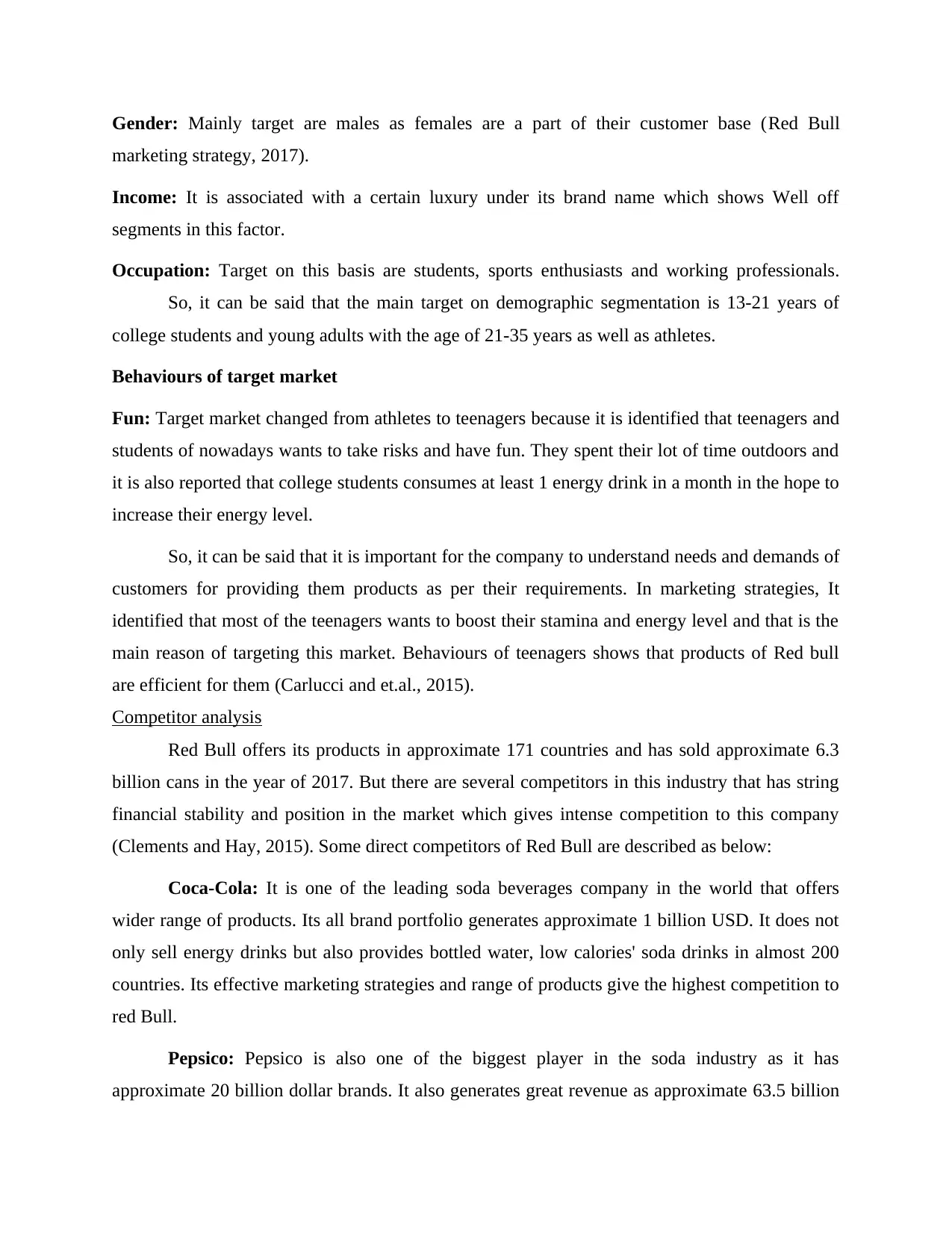
Gender: Mainly target are males as females are a part of their customer base (Red Bull
marketing strategy, 2017).
Income: It is associated with a certain luxury under its brand name which shows Well off
segments in this factor.
Occupation: Target on this basis are students, sports enthusiasts and working professionals.
So, it can be said that the main target on demographic segmentation is 13-21 years of
college students and young adults with the age of 21-35 years as well as athletes.
Behaviours of target market
Fun: Target market changed from athletes to teenagers because it is identified that teenagers and
students of nowadays wants to take risks and have fun. They spent their lot of time outdoors and
it is also reported that college students consumes at least 1 energy drink in a month in the hope to
increase their energy level.
So, it can be said that it is important for the company to understand needs and demands of
customers for providing them products as per their requirements. In marketing strategies, It
identified that most of the teenagers wants to boost their stamina and energy level and that is the
main reason of targeting this market. Behaviours of teenagers shows that products of Red bull
are efficient for them (Carlucci and et.al., 2015).
Competitor analysis
Red Bull offers its products in approximate 171 countries and has sold approximate 6.3
billion cans in the year of 2017. But there are several competitors in this industry that has string
financial stability and position in the market which gives intense competition to this company
(Clements and Hay, 2015). Some direct competitors of Red Bull are described as below:
Coca-Cola: It is one of the leading soda beverages company in the world that offers
wider range of products. Its all brand portfolio generates approximate 1 billion USD. It does not
only sell energy drinks but also provides bottled water, low calories' soda drinks in almost 200
countries. Its effective marketing strategies and range of products give the highest competition to
red Bull.
Pepsico: Pepsico is also one of the biggest player in the soda industry as it has
approximate 20 billion dollar brands. It also generates great revenue as approximate 63.5 billion
marketing strategy, 2017).
Income: It is associated with a certain luxury under its brand name which shows Well off
segments in this factor.
Occupation: Target on this basis are students, sports enthusiasts and working professionals.
So, it can be said that the main target on demographic segmentation is 13-21 years of
college students and young adults with the age of 21-35 years as well as athletes.
Behaviours of target market
Fun: Target market changed from athletes to teenagers because it is identified that teenagers and
students of nowadays wants to take risks and have fun. They spent their lot of time outdoors and
it is also reported that college students consumes at least 1 energy drink in a month in the hope to
increase their energy level.
So, it can be said that it is important for the company to understand needs and demands of
customers for providing them products as per their requirements. In marketing strategies, It
identified that most of the teenagers wants to boost their stamina and energy level and that is the
main reason of targeting this market. Behaviours of teenagers shows that products of Red bull
are efficient for them (Carlucci and et.al., 2015).
Competitor analysis
Red Bull offers its products in approximate 171 countries and has sold approximate 6.3
billion cans in the year of 2017. But there are several competitors in this industry that has string
financial stability and position in the market which gives intense competition to this company
(Clements and Hay, 2015). Some direct competitors of Red Bull are described as below:
Coca-Cola: It is one of the leading soda beverages company in the world that offers
wider range of products. Its all brand portfolio generates approximate 1 billion USD. It does not
only sell energy drinks but also provides bottled water, low calories' soda drinks in almost 200
countries. Its effective marketing strategies and range of products give the highest competition to
red Bull.
Pepsico: Pepsico is also one of the biggest player in the soda industry as it has
approximate 20 billion dollar brands. It also generates great revenue as approximate 63.5 billion
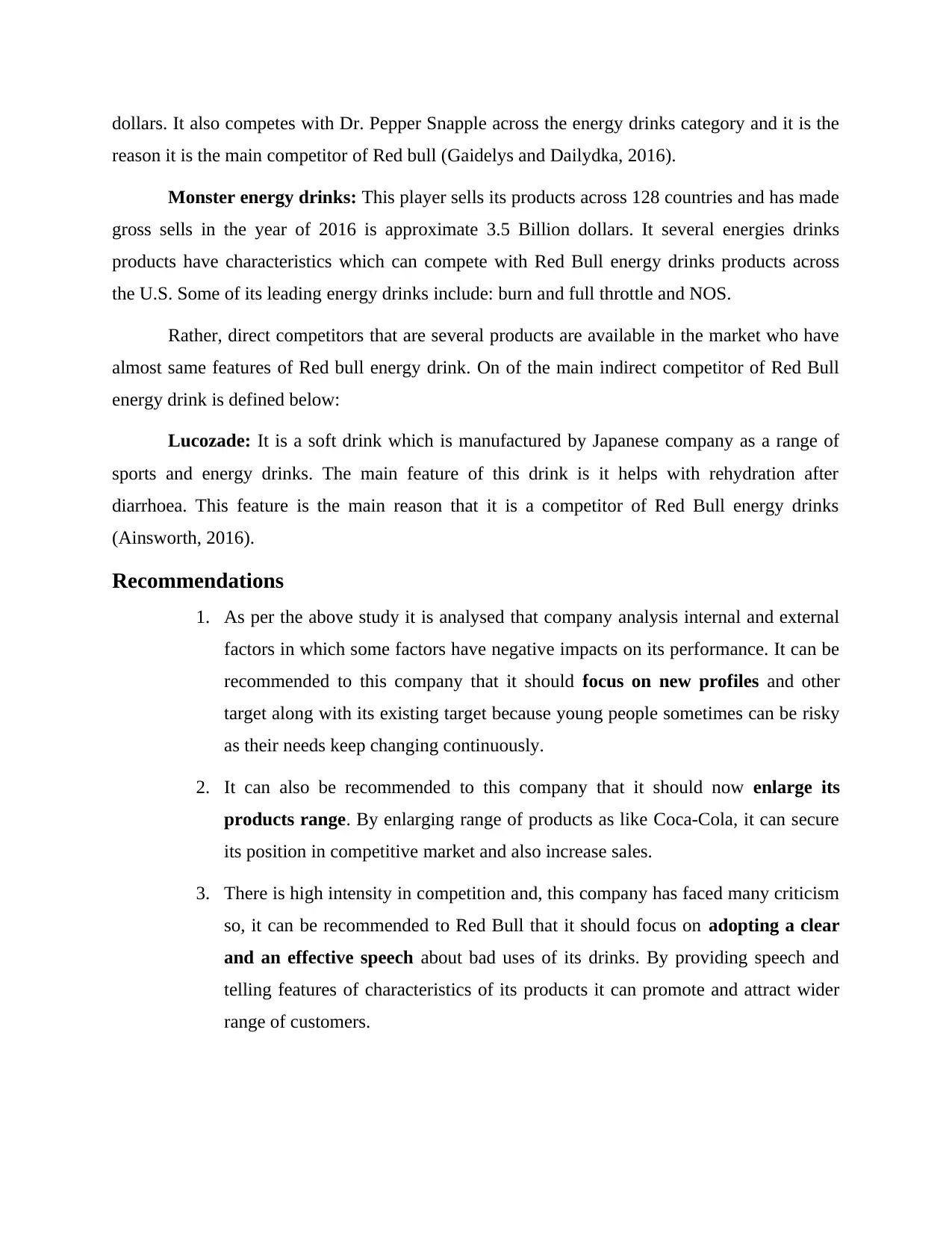
dollars. It also competes with Dr. Pepper Snapple across the energy drinks category and it is the
reason it is the main competitor of Red bull (Gaidelys and Dailydka, 2016).
Monster energy drinks: This player sells its products across 128 countries and has made
gross sells in the year of 2016 is approximate 3.5 Billion dollars. It several energies drinks
products have characteristics which can compete with Red Bull energy drinks products across
the U.S. Some of its leading energy drinks include: burn and full throttle and NOS.
Rather, direct competitors that are several products are available in the market who have
almost same features of Red bull energy drink. On of the main indirect competitor of Red Bull
energy drink is defined below:
Lucozade: It is a soft drink which is manufactured by Japanese company as a range of
sports and energy drinks. The main feature of this drink is it helps with rehydration after
diarrhoea. This feature is the main reason that it is a competitor of Red Bull energy drinks
(Ainsworth, 2016).
Recommendations
1. As per the above study it is analysed that company analysis internal and external
factors in which some factors have negative impacts on its performance. It can be
recommended to this company that it should focus on new profiles and other
target along with its existing target because young people sometimes can be risky
as their needs keep changing continuously.
2. It can also be recommended to this company that it should now enlarge its
products range. By enlarging range of products as like Coca-Cola, it can secure
its position in competitive market and also increase sales.
3. There is high intensity in competition and, this company has faced many criticism
so, it can be recommended to Red Bull that it should focus on adopting a clear
and an effective speech about bad uses of its drinks. By providing speech and
telling features of characteristics of its products it can promote and attract wider
range of customers.
reason it is the main competitor of Red bull (Gaidelys and Dailydka, 2016).
Monster energy drinks: This player sells its products across 128 countries and has made
gross sells in the year of 2016 is approximate 3.5 Billion dollars. It several energies drinks
products have characteristics which can compete with Red Bull energy drinks products across
the U.S. Some of its leading energy drinks include: burn and full throttle and NOS.
Rather, direct competitors that are several products are available in the market who have
almost same features of Red bull energy drink. On of the main indirect competitor of Red Bull
energy drink is defined below:
Lucozade: It is a soft drink which is manufactured by Japanese company as a range of
sports and energy drinks. The main feature of this drink is it helps with rehydration after
diarrhoea. This feature is the main reason that it is a competitor of Red Bull energy drinks
(Ainsworth, 2016).
Recommendations
1. As per the above study it is analysed that company analysis internal and external
factors in which some factors have negative impacts on its performance. It can be
recommended to this company that it should focus on new profiles and other
target along with its existing target because young people sometimes can be risky
as their needs keep changing continuously.
2. It can also be recommended to this company that it should now enlarge its
products range. By enlarging range of products as like Coca-Cola, it can secure
its position in competitive market and also increase sales.
3. There is high intensity in competition and, this company has faced many criticism
so, it can be recommended to Red Bull that it should focus on adopting a clear
and an effective speech about bad uses of its drinks. By providing speech and
telling features of characteristics of its products it can promote and attract wider
range of customers.
⊘ This is a preview!⊘
Do you want full access?
Subscribe today to unlock all pages.

Trusted by 1+ million students worldwide
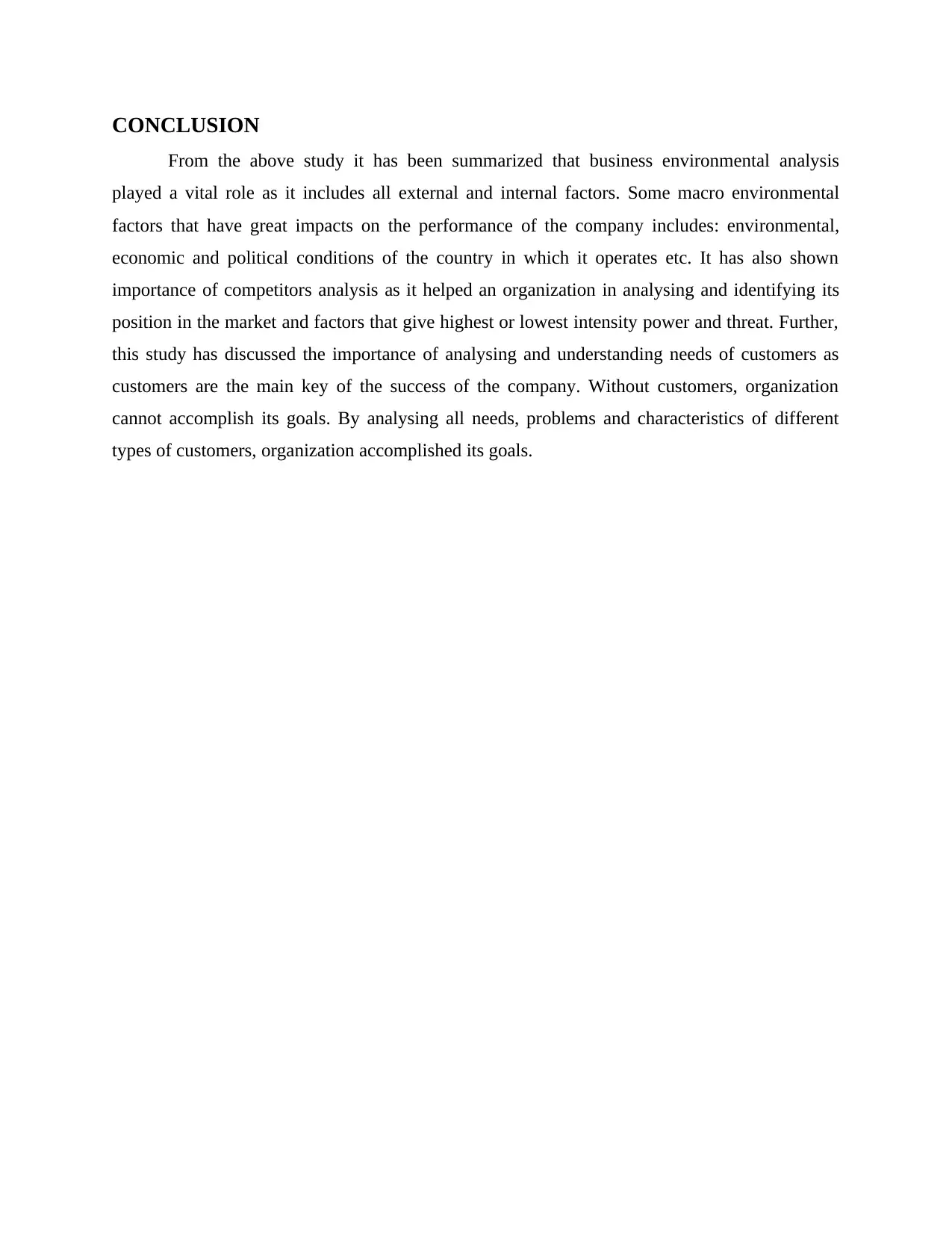
CONCLUSION
From the above study it has been summarized that business environmental analysis
played a vital role as it includes all external and internal factors. Some macro environmental
factors that have great impacts on the performance of the company includes: environmental,
economic and political conditions of the country in which it operates etc. It has also shown
importance of competitors analysis as it helped an organization in analysing and identifying its
position in the market and factors that give highest or lowest intensity power and threat. Further,
this study has discussed the importance of analysing and understanding needs of customers as
customers are the main key of the success of the company. Without customers, organization
cannot accomplish its goals. By analysing all needs, problems and characteristics of different
types of customers, organization accomplished its goals.
From the above study it has been summarized that business environmental analysis
played a vital role as it includes all external and internal factors. Some macro environmental
factors that have great impacts on the performance of the company includes: environmental,
economic and political conditions of the country in which it operates etc. It has also shown
importance of competitors analysis as it helped an organization in analysing and identifying its
position in the market and factors that give highest or lowest intensity power and threat. Further,
this study has discussed the importance of analysing and understanding needs of customers as
customers are the main key of the success of the company. Without customers, organization
cannot accomplish its goals. By analysing all needs, problems and characteristics of different
types of customers, organization accomplished its goals.
Paraphrase This Document
Need a fresh take? Get an instant paraphrase of this document with our AI Paraphraser
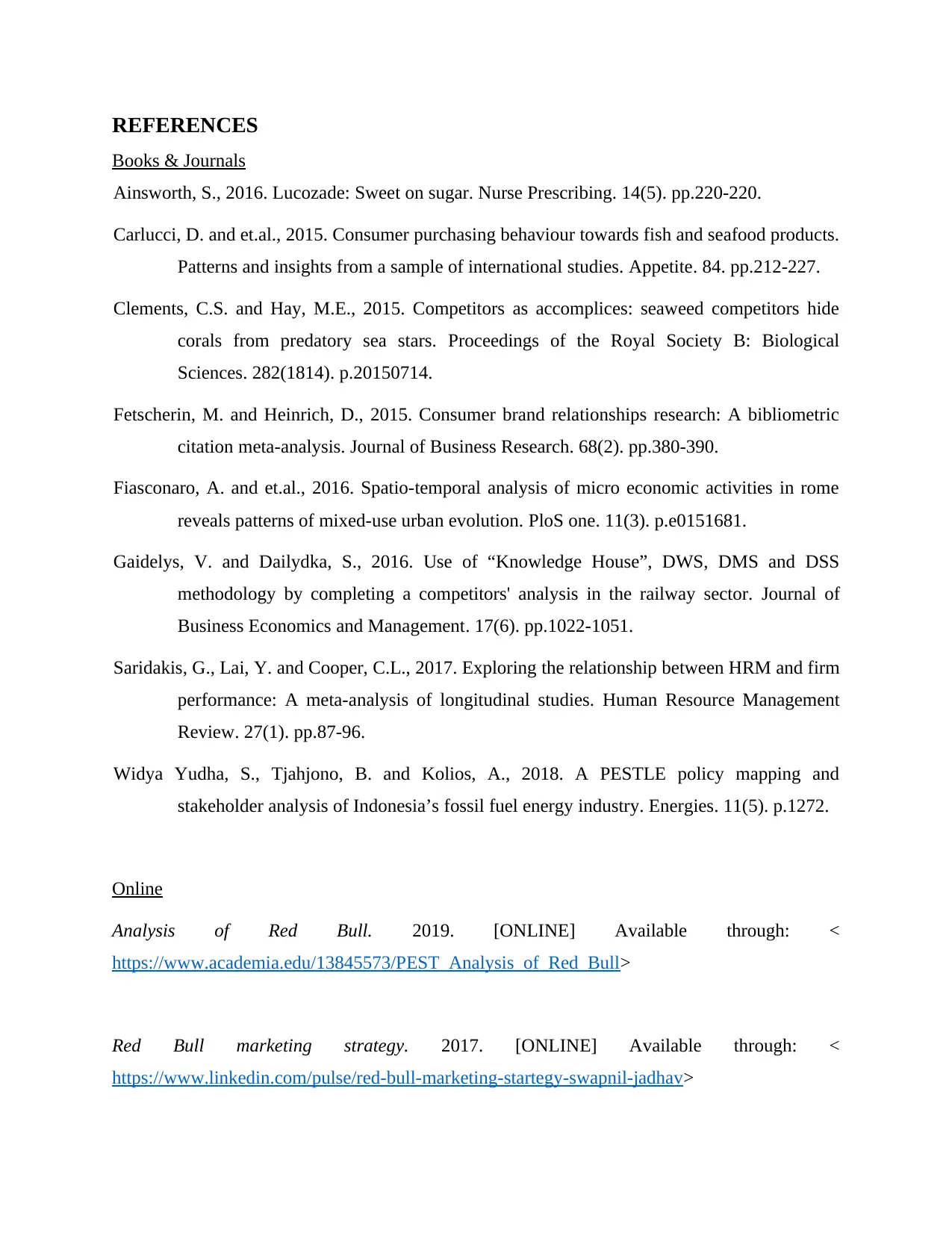
REFERENCES
Books & Journals
Ainsworth, S., 2016. Lucozade: Sweet on sugar. Nurse Prescribing. 14(5). pp.220-220.
Carlucci, D. and et.al., 2015. Consumer purchasing behaviour towards fish and seafood products.
Patterns and insights from a sample of international studies. Appetite. 84. pp.212-227.
Clements, C.S. and Hay, M.E., 2015. Competitors as accomplices: seaweed competitors hide
corals from predatory sea stars. Proceedings of the Royal Society B: Biological
Sciences. 282(1814). p.20150714.
Fetscherin, M. and Heinrich, D., 2015. Consumer brand relationships research: A bibliometric
citation meta-analysis. Journal of Business Research. 68(2). pp.380-390.
Fiasconaro, A. and et.al., 2016. Spatio-temporal analysis of micro economic activities in rome
reveals patterns of mixed-use urban evolution. PloS one. 11(3). p.e0151681.
Gaidelys, V. and Dailydka, S., 2016. Use of “Knowledge House”, DWS, DMS and DSS
methodology by completing a competitors' analysis in the railway sector. Journal of
Business Economics and Management. 17(6). pp.1022-1051.
Saridakis, G., Lai, Y. and Cooper, C.L., 2017. Exploring the relationship between HRM and firm
performance: A meta-analysis of longitudinal studies. Human Resource Management
Review. 27(1). pp.87-96.
Widya Yudha, S., Tjahjono, B. and Kolios, A., 2018. A PESTLE policy mapping and
stakeholder analysis of Indonesia’s fossil fuel energy industry. Energies. 11(5). p.1272.
Online
Analysis of Red Bull. 2019. [ONLINE] Available through: <
https://www.academia.edu/13845573/PEST_Analysis_of_Red_Bull>
Red Bull marketing strategy. 2017. [ONLINE] Available through: <
https://www.linkedin.com/pulse/red-bull-marketing-startegy-swapnil-jadhav>
Books & Journals
Ainsworth, S., 2016. Lucozade: Sweet on sugar. Nurse Prescribing. 14(5). pp.220-220.
Carlucci, D. and et.al., 2015. Consumer purchasing behaviour towards fish and seafood products.
Patterns and insights from a sample of international studies. Appetite. 84. pp.212-227.
Clements, C.S. and Hay, M.E., 2015. Competitors as accomplices: seaweed competitors hide
corals from predatory sea stars. Proceedings of the Royal Society B: Biological
Sciences. 282(1814). p.20150714.
Fetscherin, M. and Heinrich, D., 2015. Consumer brand relationships research: A bibliometric
citation meta-analysis. Journal of Business Research. 68(2). pp.380-390.
Fiasconaro, A. and et.al., 2016. Spatio-temporal analysis of micro economic activities in rome
reveals patterns of mixed-use urban evolution. PloS one. 11(3). p.e0151681.
Gaidelys, V. and Dailydka, S., 2016. Use of “Knowledge House”, DWS, DMS and DSS
methodology by completing a competitors' analysis in the railway sector. Journal of
Business Economics and Management. 17(6). pp.1022-1051.
Saridakis, G., Lai, Y. and Cooper, C.L., 2017. Exploring the relationship between HRM and firm
performance: A meta-analysis of longitudinal studies. Human Resource Management
Review. 27(1). pp.87-96.
Widya Yudha, S., Tjahjono, B. and Kolios, A., 2018. A PESTLE policy mapping and
stakeholder analysis of Indonesia’s fossil fuel energy industry. Energies. 11(5). p.1272.
Online
Analysis of Red Bull. 2019. [ONLINE] Available through: <
https://www.academia.edu/13845573/PEST_Analysis_of_Red_Bull>
Red Bull marketing strategy. 2017. [ONLINE] Available through: <
https://www.linkedin.com/pulse/red-bull-marketing-startegy-swapnil-jadhav>

⊘ This is a preview!⊘
Do you want full access?
Subscribe today to unlock all pages.

Trusted by 1+ million students worldwide

1 out of 10
Related Documents
Your All-in-One AI-Powered Toolkit for Academic Success.
+13062052269
info@desklib.com
Available 24*7 on WhatsApp / Email
![[object Object]](/_next/static/media/star-bottom.7253800d.svg)
Unlock your academic potential
Copyright © 2020–2025 A2Z Services. All Rights Reserved. Developed and managed by ZUCOL.





